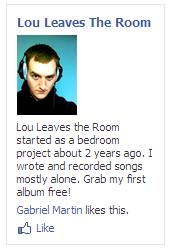A/B Testing for Musicians: A Study in Facebook Ads
This guest post is written by Chris R. at CD Baby's DIY Musican blog.
Musicians are a suspicious lot. We tend to hold fast to our gut instincts. We heed the counsel of close friends and die-hard fans. We can be defensive and protective of our artistic “purity.” We’re afraid to do anything that smacks of out-and-out marketing.
But sometimes you shouldn’t trust yourself.
Sometimes you should ignore the advice of loved ones. Sometimes you just need to get scientific about things.
Trust the numbers! They don’t lie.
A/B testing allows artists to try out variable options in an advertising campaign so you know how to best direct your efforts.
You’ve probably already conducted a very simple version of an A/B test when you decided what song should be your “single” to give away on your website, to put in the first slot of your audio-streaming player, etc. Chances are, you asked your band members, your family, your friends, and your fans which song out of a couple choices (selected by you) they liked best. But sometimes it is better to beware the feedback of family and friends.
The ones you trust can give you bad advice?
Sometimes the well-meaning, loving people in our lives just don’t think like marketers. Sometimes letting them add their two cents can derail your promo efforts. After all, they know you in an intimate way, flaws and all, and may not be comfortable with the idea that you’re trying to sell an image and persona to the world.
This ALMOST happened to Gabe Martin of the band Lou Leaves the Room, who explains his experience with A/B testing Facebook ads (and why it is so important):
I learned quite a bit with my small experiment. First, your picture matters most. When I created the page I wanted a “cool” picture. So I put on headphones, made a pouty face, and shot a closeup with my phone.
That is my “cool shot.”
My wife saw the picture, was embarrased that I would even put up such a terrible picture and insisted on another shot. So she gave me a sweater, took me outside, and had an impromptu photo session. Out came the more comtemplative, brooding shot. That is my “serious shot.”
Then I decided to make an ad. I am trying to make a splash with my upcoming second album, so I decided to offer my first album for free to boost fans to my brand new Facebook page. I created a small campaign, and made two ads. Both had the same copy/text, but one had the “cool” picture and one had the “serious” picture. Here is an example of the ad.
The ad with the “cool” shot was seen by twice as many people, clicked on twice as much and was half as expensive to run. It was very interesting. I suppose I need to take more candid cell phone shots for an effective ad campaign on Facebook. Also, I was right and my wife was wrong. She took it like a champ though.
The cost of running the ad was $30. It lead to nearly 100 fans, 200 plays, and 10-20 downloads. So, in my opinion it was money well spent. A few more runs of the ad, and I might have a real site on my hands.
-Gabe Martin
The Moral of the Story
When you can run separate ads at the same time, you have the ability to see what photos, what text, what offers, what approach works best for you. Of the two (or more), choose the one that performs higher. But never stop tweaking! It is always a good idea to keep A/B testing, even when you settle on what seems like the best ad. They can always be better!
-Chris R. at CD Baby (with much help from Gabe Martin).



Chris,
While I absolutely applaud your use of data to drive your marketing decisions (something we need a HUGE deal more of in the music business), I’ll still have to take up one point with you about the accuracy of your decision.
Even thought your “cool” pic got a higher total volume of clicks, it didn’t actually attract a significantly greater percentage of clicks.
Your click through rate was 0.030% vs 0.037%, which isn’t massive based on a sample of only 14 clicks.
Again, 99% of my sentiment is “absolutely, let’s use more data to make smarter decisions,” but I still have a niggling 1% that wants to point out that misinterpreted data is as bad as (or sometimes worse than) no data at all!
Peter
http://ampmusicmarketing.com
P.S. Sorry if your wife finds this comment and holds it against you! ;-P